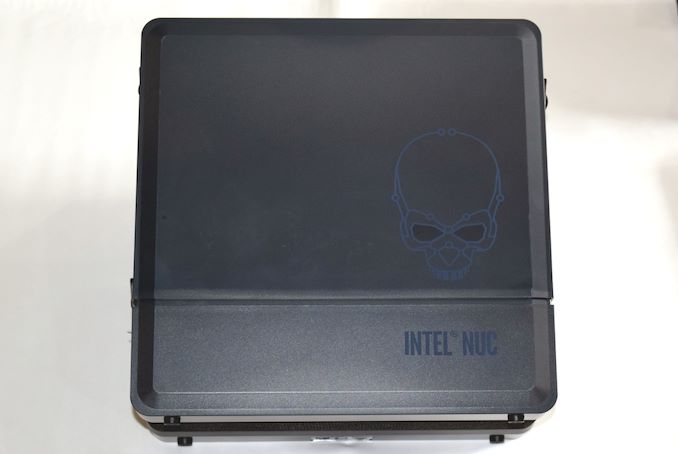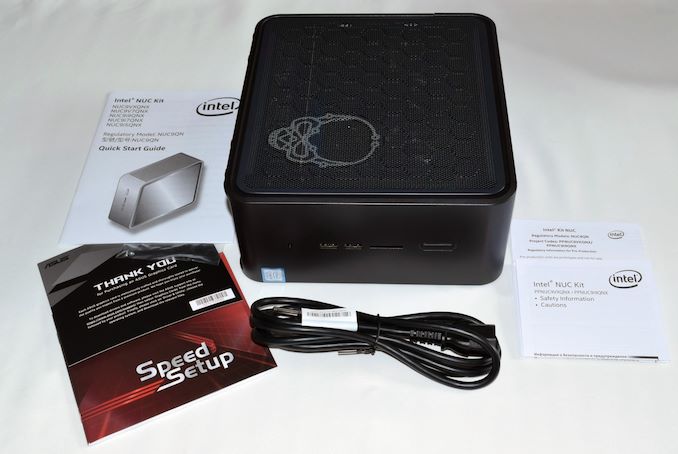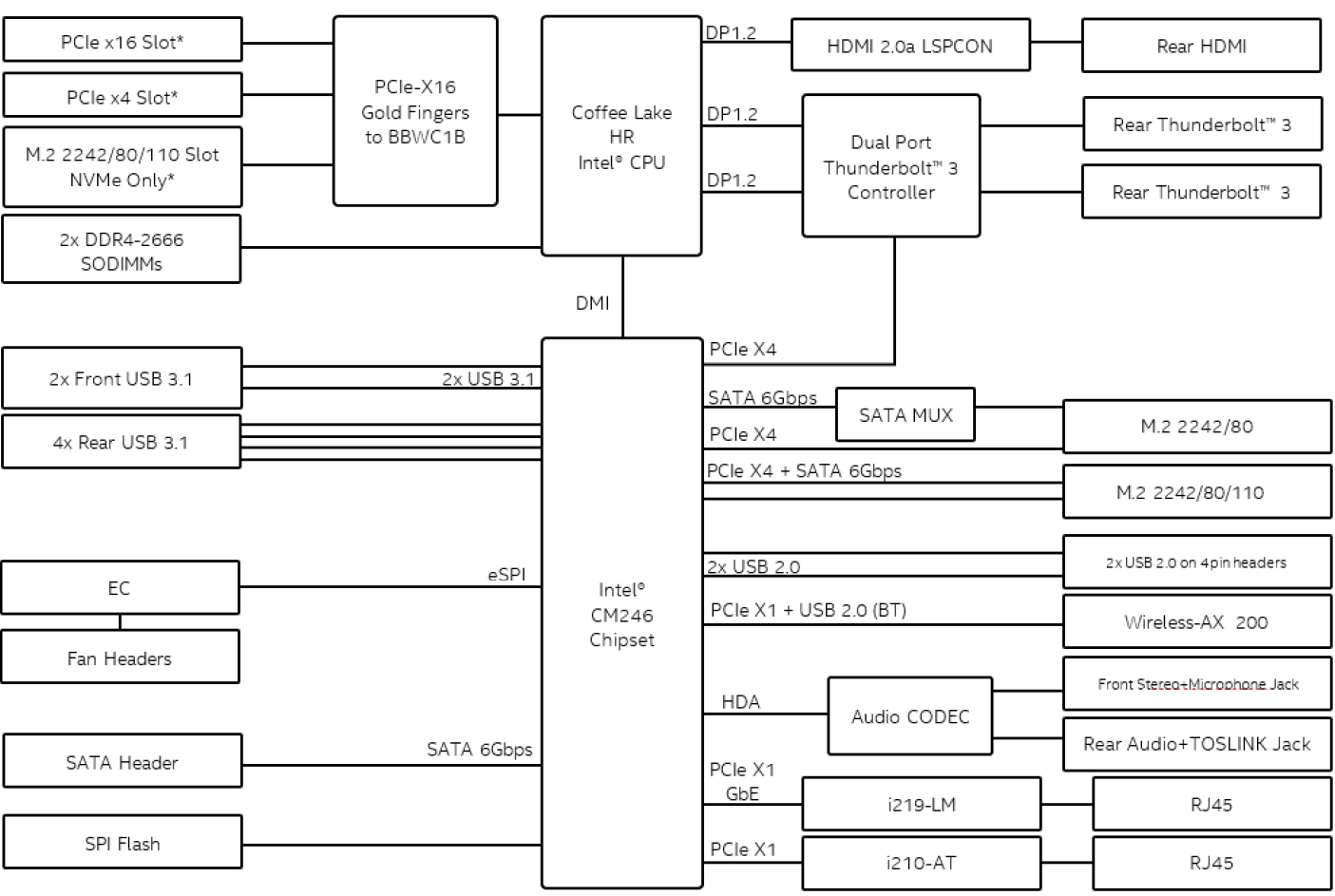Intel Ghost Canyon NUC9i9QNX Review: NUC 9 Extreme Realizes the SFF Dream
by Ganesh T S on April 16, 2020 8:05 AM ESTSetup Notes and Platform Analysis
The NUC 9 Extreme Kit is packaged in a fancy hard casing, signifying its premium nature. Since we had a system configuration essentially ready to benchmark, the package contents only included a few manuals and regulatory information notes along with a US power cord.
We noted the re-design of the Visual BIOS in our Frost Canyon NUC review. The NUC9i9QNX also uses the same re-designed interface. Unlike the mainstream NUC10i7FNH, the NUC9i9QNX has a few enthusiast options including the ability to fine-tune the DRAM timing parameters from a performance perspective. The entire gamut of options available in the latest BIOS (v0034) of the NUC9i9QNX is brought out in the gallery below.
The specifications of our Intel NUC9i9QNX review configuration are summarized in the table below.
| Intel NUC9i9QNX (Ghost Canyon) Specifications | |
| Processor | Intel Core i9-9980HK Coffee Lake-H, 8C/16T, 2.4 (5.0) GHz 16MB L2+L3, 14nm (optimized), 45W TDP |
| Memory | Kingston HyperX KHX3200C20S4/8G DDR4 SODIMM 17-19-19-35 @ 2666 MHz 2x8 GB |
| Graphics | ASUS Dual GeForce RTX 2070 MINI 8GB GDDR6 Intel UHD Graphics 630 |
| Disk Drive(s) | Intel SSD 905p Optane SSDPEL1D380GA (380 GB; M.2 Type 22110 PCIe 3.0 x4 NVMe; Optane / 3D XPoint) Kingston KC2000 SKC2000M81000G (1TB; M.2 Type 2280 PCIe 3.0 x4 NVMe; Toshiba 96L 3D TLC; Silicon Motion SM2262EN Controller) |
| Networking | Intel Wi-Fi 6 AX200 (2x2 802.11ax - 2400 Mbps) 1x Intel I219-LM Gigabit Ethernet Adapter 1x Intel I210 Gigabit Ethernet Adapter |
| Audio | 3.5mm Audio Jack (Front) Optical TOSLINK output (Rear) Capable of 5.1/7.1 digital output with HD audio bitstreaming (HDMI) |
| Miscellaneous I/O Ports | 1x UHS-II SDXC Slot (Front) 2x USB 3.2 Gen 2 (10 Gbps) Type-A (Front) 4x USB 3.2 Gen 2 (10 Gbps) Type-A (Rear) 2x Thunderbolt 3 (40 Gbps) Type-C (Rear) |
| Operating System | Retail unit is barebones, but we installed Windows 10 Enterprise x64 |
| Pricing (As configured) | $2810 |
| Full Specifications | Intel NUC9i9QNX Specifications |
The block diagram of the components of the NUC9i9QNX are presented in the diagram below.
One of the aspects that needs to be pointed out here is that the 2x Front USB 3.1 ports specified in the diagram above are physically the ones on the Compute Element, and not on the front panel of the chassis. The diagram does bring out the PCIe lanes bifurcation in the baseboard, though.
Our review sample came with Windows 10 Home x64 pre-installed, but, we wiped the drive and installed Windows 10 Enterprise x64 1909 along with the March 2020 cumulative updates prior to benchmarking. Our initial benchmarking and reports collection was done without opening up the system. The AIDA64 system report for the hardware configuration supplied by Intel provided the following information:
- [ North Bridge: Intel Comet Lake-H IMC ]:
- PCIe 3.0 x8 port #2 In Use @ x8 (nVIDIA GeForce RTX 2070 Video Adapter, nVIDIA TU106 - High Definition Audio Controller)
- PCIe 3.0 x4 port #4 In Use @ x4 (Intel Optane SSD 900p NVMe Controller)
- [ South Bridge: Intel Cannon Point CM246 ]:
- PCIe 3.0 x1 port #1 In Use @ x1 (Intel Wi-Fi 6 AX200 160MHz Wireless Network Adapter)
- PCIe 3.0 x4 port #5 In Use @ x4 (Intel Titan Ridge Thunderbolt 3 Controller)
- PCIe 3.0 x4 port #9 In Use @ x4 (Silicon Motion SM2262 PCIe 3.0 x4 NVMe 1.3 SSD Controller - Kingston KC2000)
- PCIe 3.0 x1 port #14 In Use @ x1 (Intel I210 Gigabit Network Connection)
We were puzzled by the discrete GPU operating in x8 mode instead of x16 (as it could affect gaming performance). After reaching out to Intel, we got additional context for the review configuration. As noted briefly a bit earlier, the M.2 slot on the baseboard is directly attached to the CPU, using PCIe lanes from it rather than off of the chipset. So the power-hungry, but high-performance 905p Optane drive in the baseboard slot makes sense in that context, as Intel is giving it the best possible (and least contested) connection to the CPU in order to highlight the capabilities of CPU-attached storage.
As evident from the block diagram, the Thunderbolt ports, USB ports, and the M.2 slots on the Compute Element are attached to the chipset, which means sharing the DMI link and its maximum bandwidth of PCIe 3.0 x4 (4GB/s). Which compared to typical systems, is actually a lighter load than usual; by hanging the Optane drive off of the CPU, there's less contention for the rest of the DMI link's resources, enabling additional testing areas such as elimination of noise from Thunderbolt 3 testing and allowing for RAID-0/1 on the Compute Element. Overall this opens up a few different configuration options, so in order to highlight the pros and cons of splitting the x16 slot with a SSD, we also tested the NUC with the Optane drive hanging off of the PCH, giving the video card a full x16 slot's worth of bandwidth. This is noted as x16 in the rest of the review to signify the operation of the RTX 2070 in x16 mode.
The AIDA64 system report for the x16 configuration has a slightly tweaked version of the PCIe lane usage specified earlier:
- [ North Bridge: Intel Comet Lake-H IMC ]:
- PCIe 3.0 x16 port #2 In Use @ x8 (nVIDIA GeForce RTX 2070 Video Adapter, nVIDIA TU106 - High Definition Audio Controller)
- [ South Bridge: Intel Cannon Point CM246 ]:
- PCIe 3.0 x1 port #1 In Use @ x1 (Intel Wi-Fi 6 AX200 160MHz Wireless Network Adapter)
- PCIe 3.0 x4 port #5 In Use @ x4 (Intel Titan Ridge Thunderbolt 3 Controller)
- PCIe 3.0 x4 port #9 In Use @ x4 (Intel Optane SSD 900p NVMe Controller)
- PCIe 3.0 x1 port #14 In Use @ x1 (Intel I210 Gigabit Network Connection)
- PCIe 3.0 x4 port #21 In Use @ x4 (Silicon Motion SM2262 PCIe 3.0 x4 NVMe 1.3 SSD Controller - Kingston KC2000)
The NUC9i9QNX is a relatively unique system. We have evaluated SFF systems with discrete GPUs in the last few years. Systems such as the Hades Canyon NUC came with a co-packaged discrete GPU leaving no scope for the end-user to upgrade the graphics performance without buying an entirely new computer. We've also had systems with a real discrete GPU such as the ASRock DeskMini Z370 GTX1060 and the Zotac ZBOX MAGNUS EN1080K. Theoretically, users could upgrade the installed MXM card to get better graphics performance, but practically speaking, MXM card upgrades are incredibly rare and almost never officially supported by system manufacturers.
This leaves us with one true precursor to the Ghost Canyon NUC - the Zotac ZBOX MAGNUS EK71080. This 5.7L compact gaming powerhouse internally sports a single-fan version of the Zotac GTX 1080 Mini complete with the external PCIe power connector, and nothing preventing the end-user from replacing it with a similar-sized GPU. Obviously, Zotac would not officially support this, but it only serves to show that accommodation of user-replaceable discrete GPUs in compact SFF systems has been possible before. The Compute Element initiative from Intel has been accompanied by the creation of an ecosystem where add-in card vendors now have an incentive to create discrete GPU cards within the 202mm x 131mm form-factor. Along with chassis designs like the one in the NUC9i9QNX, this has now enabled sub-5L systems capable of sporting powerful user-replaceable discrete GPUs.
In the table below, we have an overview of the various systems that we are comparing the Intel NUC9i9QNX against. Note that they may not belong to the same market segment. The relevant configuration details of the machines are provided so that readers have an understanding of why some benchmark numbers are skewed for or against the Intel NUC9i9QNX when we come to those sections.
| Comparative PC Configurations | ||
| Aspect | Intel NUC9i9QNX (Ghost Canyon) | |
| CPU | Intel Core i9-9980HK | Intel Core i9-9980HK |
| GPU | ASUS Dual GeForce RTX 2070 MINI 8GB GDDR6 Intel UHD Graphics 630 |
ASUS Dual GeForce RTX 2070 MINI 8GB GDDR6 Intel UHD Graphics 630 |
| RAM | Kingston HyperX KHX3200C20S4/8G DDR4 SODIMM 17-19-19-35 @ 2666 MHz 2x8 GB |
Kingston HyperX KHX3200C20S4/8G DDR4 SODIMM 17-19-19-35 @ 2666 MHz 2x8 GB |
| Storage | Intel SSD 905p Optane SSDPEL1D380GA (380 GB; M.2 Type 22110 PCIe 3.0 x4 NVMe; Optane / 3D XPoint) Kingston KC2000 SKC2000M81000G (1TB; M.2 Type 2280 PCIe 3.0 x4 NVMe; Toshiba 96L 3D TLC; Silicon Motion SM2262EN Controller) |
Intel SSD 905p Optane SSDPEL1D380GA (380 GB; M.2 Type 22110 PCIe 3.0 x4 NVMe; Optane / 3D XPoint) Kingston KC2000 SKC2000M81000G (1TB; M.2 Type 2280 PCIe 3.0 x4 NVMe; Toshiba 96L 3D TLC; Silicon Motion SM2262EN Controller) |
| Wi-Fi | Intel Wi-Fi 6 AX200 (2x2 802.11ax - 2400 Mbps) |
Intel Wi-Fi 6 AX200 (2x2 802.11ax - 2400 Mbps) |
| Price (in USD, when built) | $1553 (barebones) $2810 (as configured) |
$1553 (barebones) $2810 (as configured) |



















109 Comments
View All Comments
Silma - Friday, April 17, 2020 - link
Just saw your gaming benchmarks are in 720p. Why?If this computer can't have decent gaming at 1080p, what's the point of spending $1,300 ?
ganeshts - Friday, April 17, 2020 - link
Some are at 720p to provide context when compared with older SFF PCs we have evaluated before. Every benchmark has a 4K entry too. Please click the appropriate selection button to view the 4K comparison graph.nandnandnand - Friday, April 17, 2020 - link
Turn your script blocker off if you don't see any buttons for 1080p, 2160p, etc.ballsystemlord - Friday, April 17, 2020 - link
@Ganesh This review is far more complete then the recent AMD laptop one. Why?I was really hoping for more details but then thought you might have reduced the amount of benchmarks only to see you're fine review on this NUC.
ganeshts - Friday, April 17, 2020 - link
Different reviewers having different amounts of time to spend on a particular review. Ian covers a lot lot more things than I do (I publish one or two pieces a month, Ian publishes two or three a week)ballsystemlord - Friday, April 17, 2020 - link
I'm sorry to hear that Ian's so busy. Thanks for your fast reply!ballsystemlord - Friday, April 17, 2020 - link
I noticed one spelling error (I didn't read the whole thing throughly):"Though make no mistake: while biggest than the smallest NUCs, this is still well within the realm of SFF PCs."
Incorrect suffix:
"Though make no mistake: while bigger than the smallest NUCs, this is still well within the realm of SFF PCs."
Namisecond - Friday, April 17, 2020 - link
Ganesh brings up an interesting comparison to the Zotac discrete GPU boxes. Those are very hit or miss, because of their very niche, boutique pricing and Intel wants to charge almost double what Zotac is charging. They're both in the same, roughly 5 Liter, range with a very similar features list, including a standard PCIe graphics card on a PCIe x16 slot. But how does that compare to a DIY enthusiast build?Well I've got news for Intel. I just built a 5.25 Liter SFF PC using off-the-shelf, industry standard desktop components for around $700USD (the BoM might be $800 now). The ease of upgrading and appearance is arguably better too. No cheap plastic trim. If something breaks, I can hit up a plethora of 3rd party vendors for spare parts. Why did I build this specific machine? Because of the hype around the NUC 9 announcement 3-4 months back. I wanted to see where the state of DIY SFF was. Back in the days when I first got started building SFFs, case choices were very slim and they were pretty big. It all came down to the enclosures. Now with cases like the Velka 3, the Geeek A30 and the no-name Shenzen K39, companies like Zotac and Intel have to step up their game, especially for the prices they're charging. For Zotac, I think they'll continue on doing as they have. The price premium they charge can be justified, to an enthusiast, as time saved in sourcing and building. Intel's NUC 9 on the other hand....probably won't do very well. The price premium they charge is very hard to justify, considering vendor and platform lock-in...unless you place a high value on bragging rights.
Deicidium369 - Sunday, April 19, 2020 - link
I have had NUCs since the first model and have over 60 deployed as we speak. The original was used non stop for 3 years as a MQTT server - and had never had issues - I have had absolutely zero failures or issues - did get a bum stick of RAM that took a bit to diag.I agree that this and the Comet Lake NUC will not do great - I think Comet Lake in general is not going to do well - even if you need a machine TODAY, and want an upgrade path to Rocket Lake fine - socket compatible - but won't have PCIe4 that the "Z590" will have so....
Am looking forward to the NUC10 with Tiger Lake.
kwinz - Friday, April 17, 2020 - link
If you are wondering about similar size AMD Zen2 8 core products check out the HP EliteDesk 705 G5 Small Form Factor computer. It's absolutely amazing for the size and comes with up to 4 year on site warranty for business customers.